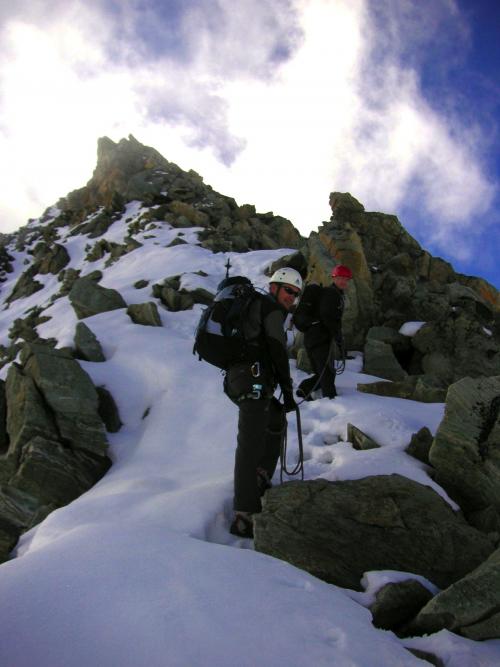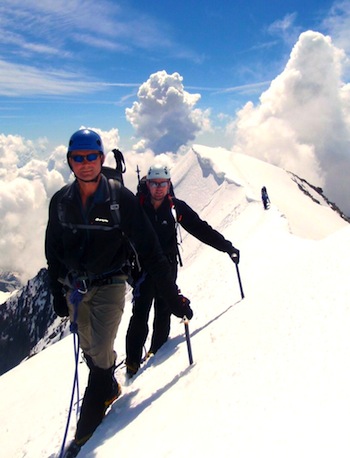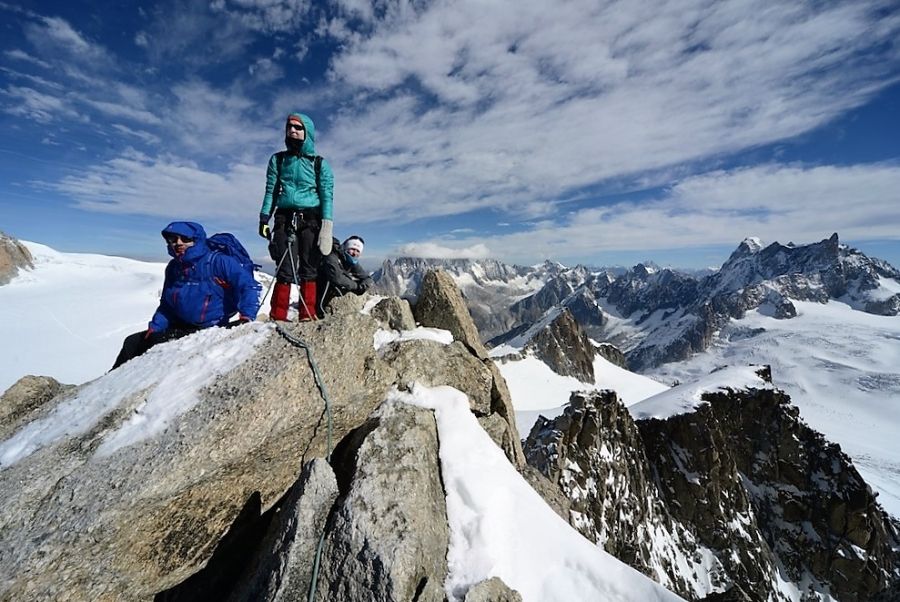The summer is here and it's time to start thinking about alpine mountaineering again. Undertaking an alpine adventure as an independent team from the UK can seem like a daunting proposition with many new skills to learn. This is partly the appeal of alpine climbing, with it having many facets which take time to master: after 25 years of climbing in the Alps I still learn new things every season.
The core skills can be divided into personal climbing skills, terrain evaluation, weather conditions, navigation and rope skills. When you have mastered all these concepts you'll be climbing the North Face of the Eiger like Uli Steck!
An Ecole du Glace forms the backbone of any alpine training course. Movement coaching is the key point here. Learning how to use your crampons and ice axe climbing and descending on different angle ice and snow slopes. It's important you gain confidence hear rather than be terrified 1000m up a 50 degree ice slope! Moving safely on a wet glacier (snow covered) involves taking coils and roping up for glacier travel. When roping up the correct distance between mountaineers needs to be practiced along with safely negotiating crevassed areas. Other skills practiced on the glacier should include prussicking out of a crevasse and ice climbing. Snow and ice belays are also essential so we practice building ice screw belays and abolakov threads.

Glacier travel has been covered in my previous article on glacier treks. Remember to take coils, keep the rope tight and have sufficient rope separation between each climber.
Unless you intend writing a 'Touching the Void'-style book then avoiding crevasses is a sensible idea! However, even the most cautious of mountaineers can step into them. Most of the time this is no big drama if you are observing good practice. If it all goes 'Pete Tong' then you need to know how to extract yourself and your mates from the void.
A group haul can be used with a big team. With 3 or more people you can just walk backwards and haul the person out. Make sure you prepare the edge of the crevasse and communicate with the victim so as not to injure them with an over enthusiastic 'tug of war'!
Self-Rescue Prussicking is used when there are just two people. The climber at the top acts as an anchor (and builds a belay) whilst the climber in the crevasse prussicks out. This is a strenuous process and needs to be practiced before you are above a bottomless black hole.
Crevasse Rescue pulley systems are used when the first two don't work. This might be needed if the crevassed climber is unconscious. Setting up a belay and building a 3:1 pulley system is a serious business bearing in mind you and your friends life will be relying on the anchors you build! In my experience this system is rarely needed and your probably better off calling for help on your mobile phone.
Moving Together is incredibly important safety factor in the Alps as the size of the mountains are so much bigger than the UK. The skill is knowing just how and when to do this on varying types of terrain. Most climbers from the UK are used to taking all day over a couple of hundred meters of climbing which allows for a leisurely approach to pitched climbing. In the Alps speeding the process up is key to not getting benighted on a route. Every summer I guide routes all over the Alps and see climbers making the same errors I made 20 years ago. It's all part of the alpine learning process where LFF is key (Light, Fast...... and Freezing if you get benighted). The best terrain to practice on in the UK are graded scrambles where you direct belay and use minimal amounts of protection whilst moving together. The aim is to think like an alpinist and make appropriate decisions and moving as quickly and efficiently as possible whilst maintaining a level of safety appropriate to the terrain.

When I began many years ago alpine climbing guidebooks were pretty rubbish with very little pictorial information and longwinded descriptions. Some routes in the old alpine club guidebook had 4 pages of text that have now been superseded by 1 page with a colour, annotated topo. Route Finding is the biggest cause of time loss and 'straying off route' can be very dangerous due to the large amount of loose rock present on alpine peaks. A good mountaineer needs to have an eye for the line. This can be practiced; looking for footprints, worn rock, fixed equipment and which way looks like the 'easiest line' all need to be considered before you end up on vertical rubble! Many times I have convinced myself the route line goes up somewhere it doesn't so be wary and do your homework try and get good pictures and topos, otherwise you might mistake the Aiguille du Blatiere for the Aiguille du Peigne in the mist (I did!).
Navigation in the Alps requires much the same skills as in the UK but with the added complication of glaciers, crevasses and early starts in the dark. A map and compass is essential just like anywhere else, and altimeter watches are indispensable for open glaciers and showing how far it is to the summit. GPS are becoming common but should be used as a back up and if you have to use one the question you should be asking yourself is: is the weather that bad that we should be out climbing?
Climbing safely in the Alps also depends on you identifying and minimising key alpine hazards. These include:
The Sun – Obvious really, on a glacier it can go 'thermonuclear' in the mid day sun.
Temperature – Alpine temperatures can range from plus 30 (dehydration) to minus 20 (frost bite) in the summer
Altitude – Good acclimatisation can prevent the onset of Acute Mountain Sickness
Glaciers and Crevasses – Avoid falling into them! This is where good navigation helps.
Weather and Storms – Poor weather can hamper navigation and summer storms can create lightning which is never good when your on top of a peak with a metal ice axe.
Rockfall – Warm weather in the Alps can allow ice holding the rock together to melt. This can be a danger below rocky peaks and near steep glacial moraine.
Ice Fall and Avalanches – Seracs are ice cliffs on glaciers and at some point you will have to walk under one. There is always a risk this might topple over as it moves down hill. Again, judgment is needed and don't stop to have a picnic underneath one!
The Alps has an amazing network of Alpine Huts which cater for mountaineers who don't want to camp or Bivouac. They operate like a basic hostel with dormitory accommodation, breakfast and evening meals.
The two things you must do are: 1. Ring up and reserve your bed in advance 2. If you change your plans you must cancel your booking in advance. This is an important safety consideration as if you book and don't turn up they might send a search party to find you. They are also a useful source of information for route conditions in there area.
We run our Alpine Introduction Courses in Chamonix as there are plenty of easily accessible routes for the Alpine novice. The Arolla area is also good for easy alpine peaks but you do end up walking long distances to get to the meat of the climbing!
Ideal routes to hone those alpine skills around Chamonix might include:
Crochues Traverse – This is perfect for learning to move together over rocky ground and hone your rope work. Located in the Aiguille Rouge nature reserve it is ideal for acclimatisation.
Aiguille du Tour – This was my first alpine peak. It has a glacial approach and some excellent rocky scrambling to the summit with unparalleled views to Mont Blanc and the Chamonix Aiguille.
Tete Blanche – Opposite the Aiguille du Tour and a good training climb for glacial travel and moving together.
Petite Aiguille Verte – A mini classic from the Grand Montets cable car. It has ice, rock and snow so its a good all round work out.
Aiguille D'Entreves – Another great rocky ridge traverse in a high alpine setting above the Torino Hut on the Italian side of the Valley Blanche. It's well protected and not overly long so ideal for a first timer.
Another thing to understand are Alpine Sandbags! These are routes that are billed as 'easy days' for the 'beginner alpinist' but in reality should not be underestimated. Two classic spring to mind;
The Arete du Cosmique is not very long (I guide it in under 3 hours) but its quite technical. I have seen many a climber struggling on the trickier pitches and cursing the grade! Start early then you have plenty of time and avoid the crowds.
The Midi Plan Traverse is billed as a fairly easy trip from the Aiguille du Midi but, again, it’s a long day. It's not overly technical, but when it’s icy it can feel pretty out there and exposed. I would suggest starting early and take a head torch just in case. If all else fails you can Bivouac in the cable car station or stay at the Cosmique Hut on the way back.
GEAR
Mountaineering equipment is so good now days, the choice is endless. I have discussed basic equipment needed in my last articles, below is a list of some other technical kit needed to be self-sufficient on easy rocky alpine terrain.
Shared
Rope – A 50m light single rope will cover most bases like the - Mammut Galaxy Superdry
Basic Alpine Climbing Rack
⁃ 4 x long Quick draws (short quick draws create loads of rope drag) North Ridge Gamma
⁃ Rocks / Stopper Set BD Stoppers 1-13 (I would leave sizes 1,2,3 at home)
⁃ Camming devices: 1,2 and 3 Helium Friends
⁃ 2x 60cm slings Wild Country
⁃ 2x 120cm slings Wild Country
⁃ 4x Crabs for the above slings North Ridge K2 Gamma
Individual's Equipment
Prussick Loops – 2 x 1.5 m of 6mm cord tied in a loop – 6mm Cord
Belay Device – North Ridge
3x Crabs - North Ridge K2 Gamma
3x Locking Crabs – North Ridge K1N Alpha
1x Quickdraw - North Ridge Gamma
1x 120cm Sling - Wild Country
2x 18cm Ice Screws – Grivel Helix
Jamming Device to supplement Prussick Loop – WC Ropeman
4m of 6mm Cord to use for abseiling emergencies!
This is not an extensive alpine rack - it's just the basics needed to get started. Whilst writing this article I did come across some reviewers on the GO website who were confused as to who 'North Ridge' are. Well, its GO's own branded kit - which is amazing value! I couldn't believe the prices, If I didn't get my own free kit I would be getting a set of those Gamma quick draws (which are actually made by Grivel).
To delve into greater detail try these two resources: the BMC have produced an excellent video covering all the basic Alpine Climbing Techniques . Another excellent instructional book is Alpine Mountaineering by Bruce Goodlad.
If this seems rather daunting the Mountain Tracks offer 3 courses to get you started on Alpine Terrain:
Alpine Introduction Course
Expedition Training and Glacier Travel
Best of Chamonix Weekend
Next month’s article will be a guide to the best non-technical 4000m peaks in the Alps that are achievable for most fit UK hill walkers.
Olly Allen
 Off-Piste
Off-Piste Ski Touring
Ski Touring Via Ferrata
Via Ferrata Ice Climbing
Ice Climbing Alpine Glacier Trekking
Alpine Glacier Trekking Worldwide Trekking
Worldwide Trekking






 Travel Website Development
Travel Website Development